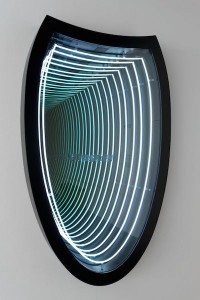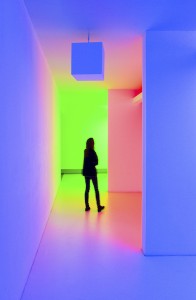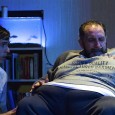
David Batchelor
Magic Hour, 2004/2007
Installation View Light Show Hayward Gallery, 2013 © The Artist 2015
Photo: Marcus J Leith
Sydney’s Museum of Contemporary Art has turned the lights on sculptures and artificial light installations to transform the space and alter perception until July 10.
Throughout the exhibit, light – something we take for granted in our every day lives – is used as a wonderful tool to illuminate the imagination. Each work of art expresses its own message, some abstract, others irrational, but all relevant to modern life.
The very first piece of the exhibit, “Exploded View (Commuters)” by Jim Campbell, is amazingly well set with more than 1000 LED bulbs where shadowy figures of commuters dissolve and resolve. This invites the viewer to move and position in a certain way to understand the artwork and its familiarity in our lives.

Iván Navarro
Burden (Lotte World Tower) 2011. Installation view Light Show, Hayward Gallery, 2013 © the artist 2015 Photo: Marcus J Leith
Next to it is “Burden” by Ivan Navarro, a series of neon light boxes that the artist has modelled on architectural footprints of skyscrapers from around the world. The written word “Burden” repeats and resonates endlessly and ominously.
From the same artist, “Reality Show (Silver)” invites the visitor to an experience not recommended for claustrophobics. Navarro grew up in Chile during the military dictatorship, an era of control and repression, and reflects this through an oppressing bright phone box-like cubicle.
Locked between four doors on about a square metre, visitors can see their reflection surrounding them. At the same time, all viewers outside the box can see inside – just like one-way mirrors during interrogations. But the artwork is not just a piece of social commentary; it also conveys a wonderful feeling of poetry, warmth and peace.
Next to each other, “S=U=P=E=R=S=T=R=U=C=T=U=R=E” by Cerith Wyn Evans and “Cylinder II” by Leo Villareal resonate on Light, Earth, Sun and Stars.
Evans’ work shows three tall illuminated columns with very warm and bright incandescent strip lights. When they turn on, the three columns feel alive and spiritual. “Because of the way they are made to behave, they are relatively invisible. They are in suspension, between heaven and earth. They have a life on their own,” Evans explains.

Carlos Cruz-Diez
Chromosaturation, 1965-2013 Galeries Nationales Du Grand Palais, 2013 © Carlos Cruz-Diez/ADAGP, Paris 2015
On the other side, Villareal’s work uses much more modern technology with 19,600 LED lights that constantly fluctuate. But the spiritual message is as meaningful with random performance of dancing stars and fireworks of falling snow.
Finally lights can also challenge the viewer physically. With “Chromosaturation” by Carlos Cruz-Diez, the visitor is immersed in a monochrome world of red, blue or green. The experience is unreal and unexpected. The eyes can have a rest watching “Magic Hour” by David Batchelor, an artificial sunset that imitates the twilight sky above Las Vegas.
Even though the exhibit seems quite small and is quickly over, it is quite surprising how a light installation can have so much impact on the imagination. From the reality of our daily lives to abstract thought and space, light can convey so much to challenge both the viewer and the artist.




